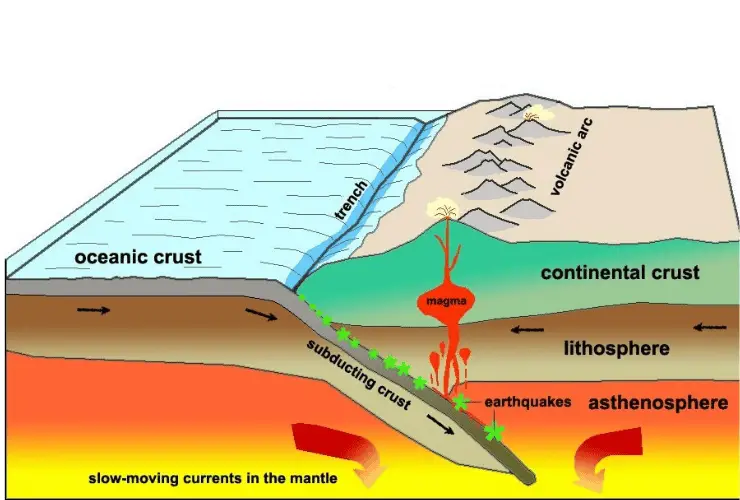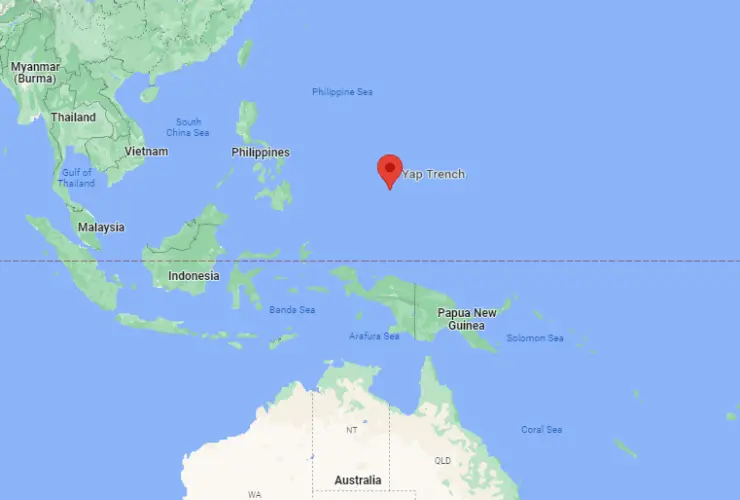The Yap trench is a long, narrow, steep-sided, deep depression in the oceanic crust near the Yap Islands, located in the Pacific Ocean. Subduction zones usually cause it. For this reason, this trench is called the submarine trench of the Pacific Ocean.
Are you feeling thirsty to know more about Yap trench? To quench your thirst, here are all the facts about this trench that you may not know.
Yap Trench
Yap trench is also known as the “West Caroline Trench.” Between the Mariana Trench and the Palau Islands, this trench makes up a portion of the Pacific Ring of Fire. Volcanic eruptions and earthquakes are common in this area known as the Ring of Fire, which surrounds much of the Pacific Ocean’s perimeter.
The horseshoe-shaped Ring of Fire extends for approximately 40,000 kilometers (25,000 miles) in length and can be up to approximately 500 kilometers (310 miles) wide.
The Yap Trench is located along the network of trenches that extends from the Bering Sea’s southwestern boundary to the Philippine Trench’s southernmost point (Mindanao Trench).
The chain also consists of the Izu, Japan, Kuril, and Mariana trenches, in addition to the Yap Trench. The Trieste Depth (36,201 feet; 11:034 m) is the deepest point in the Pacific Ocean and can be found close to where the Mariana and Yap trenches meet.
How Was the Yap Trench Formed?
Yap trench was formed as a result of the Yap Plate subducting beneath the Philippine Sea Plate at a rate of approximately 6.5 cm (2.6 inches) per year. Yap trench is located in an area known for its active seismic activity and violent earthquakes, which have been documented throughout history.
How Deep Is the Yap Trench?
The Yap Trench is located northeast of the Palau Islands and stretches for about 400 miles (650 km). It has a maximum depth of 27,976 feet (8,527 m). For this depth, the Yap trench is considered another deep subduction zones on Earth.
Want to know what is the water pressure at this depth? It’s more than 12000 PSI.

Is There Any Life in Yap Trench?
You may think it’s not possible for any life to exist in such deep surroundings of the Yap trench, but you would be surprised to know that, recently, it has been found that the Yap trench is home to a variety of organisms such as tube worms and viruses.
Also, some marine reports show that snailfish species like Pseudoliparis Swirei are found at such a deep Yap trench.
People often wonder if different sea monsters, like giant octopuses or squids, live in the deep trenches. But so far, these are only myths with no concrete evidence to support them.
Can Humans Survive at A Depth Of The Yap Trench?
Before 2022 it was impossible for humans to survive the Yap trench’s extreme pressure and darkness, but recent technological advancements allowed submarines like Hadal-Explorer to reach the Yap trench.
Though it is quite difficult for humanoids to survive at the Yap trench’s depth, scientists have made extraordinary progress as they attempt to learn more about the ocean’s deepest regions.
This year, Caladan Oceanic founder, Explorer Victor Vescovo, was the first to dive to the bottom of the Yap and Palau trenches. Micronesian Master Navigator Sesario Sewralur accompanied him.
Keep Note-
#1. Known as the “West Caroline Trench” and “Submarine Trench.”
#2. Maximum Depth: 27,976 feet (8,527 m).
#3. Water pressure is above 12,000 PSI.
#4. One snailfish species Pseudoliparis Swirei and some viruses are discovered.
#5. The first human to reach the Yap trench was Victor Vescovo in 2022.
Conclusion
So, here is everything about the Yap trench, which is a unique and mysterious place. This trench located in the Pacific Ocean is an area full of seismic activity and some of the deepest depths known on Earth.
Yap Trench has been recently explored by advanced technology, with Hadal-Explorer making it to its bottom, allowing us to understand and explore this mysterious place.
Also, it is full of mysterious creatures and organisms that exist under its pressure, challenging our understanding of the ocean’s depths. I hope Yap trench continues to be a fascinating place for exploration and discovery.
Image source: Google Map and gotbooks.miracosta.edu


13 thoughts on “Yap Trench: The Submarine Trench of The Pacific Ocean”